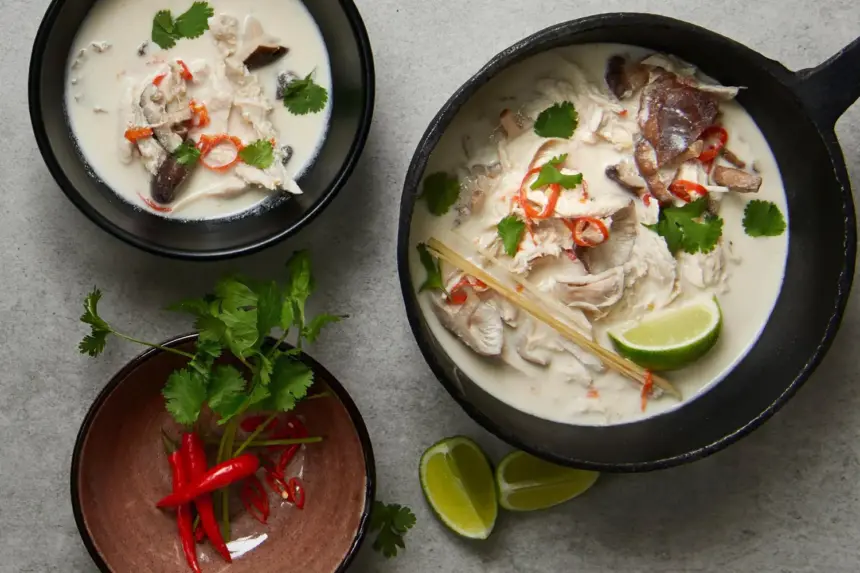Thai Food: Tom Kha Kai (Coconut Chicken Soup)
Tom Kha Kai, or Coconut Chicken Soup, is a classic Thai dish renowned for its rich, fragrant flavors and creamy coconut milk base. Known for its balance of tangy, savory, and mildly spicy tastes, this soup is a favorite among both locals and visitors to Thailand. It’s a dish that embodies the complexity and harmony of Thai cuisine, offering a comforting yet exciting blend of ingredients.
In this article, we’ll explore the origins of Tom Kha Kai, its essential ingredients, the preparation process, and why it has become one of the most popular Thai dishes worldwide.
The Origins of Tom Kha Kai
The name “Tom Kha Kai” can be broken down into three parts: Tom means “boiled,” Kha refers to galangal, and Kai means “chicken.” While it shares some similarities with Tom Yum soup, another famous Thai dish, Tom Kha Kai is distinguished by its use of coconut milk and galangal, which give it a milder and creamier profile compared to the sharper, more acidic taste of Tom Yum.
Tom Kha Kai is believed to have originated in the central or northern regions of Thailand, where coconut milk is a common ingredient, particularly in curries and soups. However, it’s not only popular in Thailand—this dish is also widely consumed in Laos, where it’s known as Tom Kha Gai and often made without coconut milk. Over the years, Tom Kha Kai has spread throughout Southeast Asia and gained a strong international following.
The Unique Flavors of Tom Kha Kai
What sets Tom Kha Kai apart from other Thai soups is its combination of coconut milk with traditional Thai herbs. The coconut milk provides a rich, creamy base that is both soothing and indulgent, while the herbs—like galangal, lemongrass, and kaffir lime leaves—infuse the soup with aromatic and slightly spicy notes. The dish strikes a perfect balance between the sweetness of the coconut milk, the acidity of the lime juice, and the earthy spiciness of the galangal and chilies.
While there are many variations of the recipe, the core flavors remain consistent, making it a reliable dish for those who want to experience the authentic taste of Thailand.
Essential Ingredients
Each ingredient in Tom Kha Kai plays a vital role in creating its signature taste. Let’s take a closer look at the key components of this delicious soup:
- Coconut Milk (Kati): Coconut milk is the soul of Tom Kha Kai. Its creamy texture and slightly sweet flavor provide the base for the soup, balancing the spiciness and acidity of the other ingredients. High-quality coconut milk should be rich and smooth, giving the soup its signature silky consistency.
- Galangal (Kha): Galangal, a close relative of ginger, is the defining ingredient of Tom Kha Kai. Its sharp, citrusy, and peppery flavor adds depth to the soup. Unlike ginger, galangal has a more intense and earthy taste, making it a crucial element for authentic flavor.
- Chicken (Kai): Chicken is the protein of choice in this soup, traditionally sliced into bite-sized pieces. The chicken absorbs the flavors of the broth, becoming tender and flavorful after simmering in the coconut milk. Some variations of the dish use shrimp or tofu, but chicken remains the most common.
- Lemongrass (Takrai): Lemongrass is another essential herb that adds a citrusy, refreshing note to the soup. It is usually smashed and simmered in the broth to release its oils, contributing to the soup’s overall aroma and flavor.
- Kaffir Lime Leaves (Bai Makrut): These aromatic leaves lend a bright, citrusy flavor to the soup. They are usually torn and added to the broth, infusing the soup with a distinct and fragrant taste that complements the creamy coconut milk.
- Chilies (Prik): Fresh Thai chilies are added to the soup to provide a mild to moderate heat. The level of spiciness can be adjusted depending on personal preference, but typically, Tom Kha Kai is milder than other Thai soups like Tom Yum.
- Fish Sauce (Nam Pla): Fish sauce is a staple in Thai cooking and is used to add a salty, umami-rich flavor to the soup. It enhances the overall depth of the dish and balances the sweetness of the coconut milk.
- Lime Juice (Nam Manao): Freshly squeezed lime juice adds the necessary acidity to the soup, brightening the flavors and cutting through the richness of the coconut milk.
- Mushrooms: Some versions of Tom Kha Kai include mushrooms, such as straw mushrooms or oyster mushrooms, which provide an additional texture and earthiness to the dish.
- Cilantro: Fresh cilantro is often used as a garnish to add a burst of herbal freshness to the finished dish.
Preparing Tom Kha Kai
Despite its complex flavor profile, Tom Kha Kai is relatively simple to prepare. The key to making a delicious Tom Kha Kai is to use fresh ingredients and to simmer the soup gently, allowing the flavors to meld together without boiling the coconut milk, which can cause it to curdle.
Here’s a step-by-step guide on how to prepare this delicious Thai soup:
- Prepare the Aromatics: Begin by smashing the lemongrass stalks and slicing the galangal into thin rounds. Tear the kaffir lime leaves into pieces to release their fragrance.
- Simmer the Coconut Milk and Broth: In a large pot, combine the coconut milk and a small amount of chicken broth. Bring it to a gentle simmer over medium heat, being careful not to let it boil. Add the lemongrass, galangal, and kaffir lime leaves to the pot and let them infuse the broth for 5-10 minutes.
- Cook the Chicken: Add the sliced chicken to the simmering coconut milk and cook until it’s tender and fully cooked through. If using mushrooms, you can add them at this stage as well.
- Season the Soup: Add fish sauce and sugar to taste, adjusting the seasoning until the flavors are well balanced. For a spicier soup, add sliced Thai chilies or crushed chili flakes.
- Finish with Lime Juice: Once the chicken is cooked, remove the soup from heat and stir in fresh lime juice to add a tangy finish. Be sure to taste the soup before serving and adjust the flavors if necessary. The balance of salty, sweet, and sour is essential.
- Serve and Garnish: Ladle the soup into bowls and garnish with fresh cilantro and, optionally, a few extra slices of chili for heat. The soup can be served as a main course or as part of a larger Thai meal.
Cultural Significance
Tom Kha Kai is a staple in Thai households and restaurants, often enjoyed as part of a larger meal that includes other classic Thai dishes such as pad thai, green curry, or papaya salad (som tam). Its creamy, mild nature makes it a favorite among those who may not enjoy spicier Thai dishes but still want to experience the unique flavors of Thai cuisine.
This dish is also commonly served at special occasions, family gatherings, and festivals. In Thailand, food is an integral part of socializing, and Tom Kha Kai is often part of a shared meal, encouraging conversation and connection among friends and family.
Tom Kha Kai’s Global Popularity
Over the past few decades, Thai cuisine has gained immense popularity around the world, and Tom Kha Kai has become one of the most loved Thai dishes internationally. It is widely available in Thai restaurants across the globe, often recommended to those who are new to Thai cuisine due to its mild heat and approachable flavor profile.
What makes Tom Kha Kai especially popular is its universal appeal. The combination of coconut milk, lime, and chicken creates a flavor that is both familiar and exotic, making it an accessible dish for those looking to explore the flavors of Thailand without venturing into spicier territory.
Additionally, its rich yet light texture makes it a versatile dish that can be enjoyed year-round, whether served as a comforting soup on a cold day or as a refreshing starter in warmer weather.
Variations and Modern Interpretations
While the traditional recipe for Tom Kha Kai remains the most popular, there are many regional and modern variations of the dish. For example, some versions may include shrimp (Tom Kha Goong) instead of chicken, or use tofu as a vegetarian alternative. Others may add additional vegetables, such as baby corn or spinach, to create a heartier soup.
In some interpretations, chefs may experiment with the level of heat by adding more or fewer chilies, or infuse the soup with additional herbs like Thai basil for a different flavor profile. While these variations offer new takes on the dish, the core elements of coconut milk, galangal, and lime remain consistent, preserving the essence of Tom Kha Kai.
Conclusion
Tom Kha Kai is a quintessential Thai dish that showcases the country’s ability to balance bold flavors with delicate ingredients. Its creamy coconut milk base, combined with the tanginess of lime juice and the warming spice of galangal, makes it a dish that’s both comforting and exciting to eat.
Whether you’re a seasoned Thai food lover or new to the cuisine, Tom Kha Kai is a must-try dish that offers a taste of Thailand’s culinary traditions. Its simplicity in preparation and complexity in flavor have earned it a place among the most beloved Thai dishes, both in Thailand and around the world.










